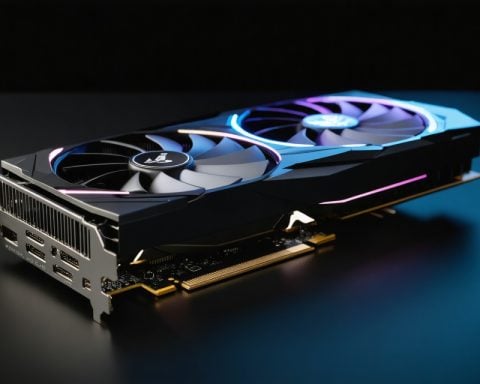- Rivian Automotive is crafting a strategy to surprise the market, dismissing doubts about its 2025 outlook.
- The company initially made waves by partnering with Amazon for 100,000 electric delivery vans but has only delivered 20,000 so far.
- Rivian’s exclusivity with Amazon is lifted, opening opportunities to serve a broader customer base beyond the retail giant.
- Commercial van orders are now available for fleets of all sizes, following successful testing phases with partners like AT&T.
- This move indicates Rivian’s recovery from supply chain challenges and potential growth in the commercial EV sector.
- The shift into the commercial van market could position Rivian alongside established players like Ford.
- Uncertainties remain about Rivian’s future relationship with Amazon and potential market volatility.
Rivian Automotive, a name synonymous with innovation in the electric vehicle arena, is quietly orchestrating its next big move as it prepares to defy the naysayers betting against its future. As whispers of a lackluster 2025 circulate, the company discreetly unveils a strategy set to shock the market.
In the not-so-distant past, Rivian captured the spotlight with a bold agreement to furnish Amazon with 100,000 electric delivery vans (EDVs). Yet, the journey has been slower than expected, with only 20,000 vans currently changing the face of logistics. The once-exclusive partnership is now open-ended, allowing Rivian to court a wider audience beyond the giant retailer, a bold maneuver that could redefine its trajectory.
A strategic silence followed, as companies took their time to evaluate and test these electric workhorses. But as anticipation quietly built, Rivian’s announcement broke the pause—commercial van orders are now open to fleets of all sizes. The company’s testing phase, notably with AT&T, has laid the groundwork for potential deals set to transform Rivian’s commercial footprint.
This move is not merely a logistical expansion; it signifies the company’s recovery from supply chain woes and a promising pivot toward growth. The commercial van market, a realm where giants like Ford Motor Company thrive, now presents a tantalizing opportunity for Rivian. Ford’s E-Transit success underscores the lucrative nature of commercial EVs, hinting at substantial gains Rivian could soon savor.
Yet, beneath this promising veneer lies a potential crack—the future of its alliance with Amazon. With Amazon’s stake in Rivian susceptible to market whims, the path forward is not without its shadows. Still, the whisper of fresh deals in the air could well become the shout Rivian needs in 2025. Investors, keep your eyes peeled; the roads may soon teeter with Rivian’s silent warriors.
Rivian’s Bold Electric Future: What You Need to Know Now
How-To Steps & Life Hacks for Investing in Rivian
1. Research the EV Market: Understand the electric vehicle landscape, focusing on market leaders like Tesla and emerging players such as Rivian. Start by reading analyst reports and following EV news platforms.
2. Monitor Rivian’s Announcements: Keep up to date with Rivian’s latest press releases and quarterly earnings calls. They often provide insights into the company’s strategy and financial health.
3. Diversify Your Portfolio: While Rivian offers exciting prospects, balance your investments across various sectors to mitigate risks.
4. Understand Supply Chain Dynamics: Rivian’s growth could be influenced by supply chain factors. Learn how global logistics might affect their production timelines.
Real-World Use Cases for Rivian EDVs
– Logistics and Delivery Companies: Rivian’s electric delivery vans (EDVs) can significantly reduce emissions for logistics companies, offering sustainability and cost savings over traditional vehicles.
– Municipal Fleets: City governments looking to transition to greener operations can adopt EDVs for public services.
– Utility Companies: Companies like AT&T have piloted Rivian’s EDVs for field operations, illustrating their potential utility across various sectors.
Market Forecasts & Industry Trends
The commercial EV market is expected to experience substantial growth in the coming years. According to a report by Allied Market Research, the electric commercial vehicle market is projected to reach $178.56 billion by 2030, growing at a CAGR of 41.1% from 2020 to 2030. Rivian’s entry into this space with its commercial vans could position it well against competitors like Ford’s E-Transit.
Reviews & Comparisons
– Rivian EDVs vs. Ford E-Transit: While Ford’s E-Transit offers robust features and a proven track record, Rivian’s EDVs offer unique design and cutting-edge technology tailored for long-term sustainability.
– User Feedback: Early users from logistics companies praise Rivian for its innovation and efficiency, albeit with some room for improvement in production speed.
Controversies & Limitations
– Supply Chain Challenges: Like many manufacturers, Rivian has faced setbacks due to global supply chain disruptions. This has impacted delivery timelines and production capacity.
– Partnership Dynamics: The future of Rivian’s relationship with Amazon remains uncertain, posing potential risks to future orders.
Features, Specs & Pricing
– Electric Range: Rivian’s EDVs boast a competitive electric range, suitable for city deliveries.
– Advanced Technology: Includes autonomous-ready hardware and over-the-air updates.
– Pricing: Currently undisclosed, but expected to be competitive with market standards.
Security & Sustainability
Rivian emphasizes sustainability, aiming for a closed-loop recycling system for batteries and sourcing materials responsibly. Their security features include advanced AI-driven driver assistance and fleet management software.
Pros & Cons Overview
Pros:
– Innovative design and tech
– Strategic partnerships (e.g., Amazon, AT&T)
– Growth potential in the commercial EV market
Cons:
– Production delays
– Dependence on key partnerships
– Competition from established brands like Ford
Actionable Recommendations
– Invest in Companies with Diverse Portfolio: If investing in EVs, consider companies with diverse products and strategic partnerships.
– Stay Updated: Regularly check Rivian’s official website or trusted industry news sources for announcements.
– Green Transition Plan: For fleet managers, consider transitioning incrementally to test and optimize integration of EDVs.
Conclusion
Rivian’s strategic pivot towards wider commercial van availability positions it uniquely amidst EV competition. While challenges remain, the promise of innovation, sustainability, and market expansion makes it a compelling contender in the electric vehicle market.
For further insights into Rivian’s journey and expansion plans, visit their official site here.


















